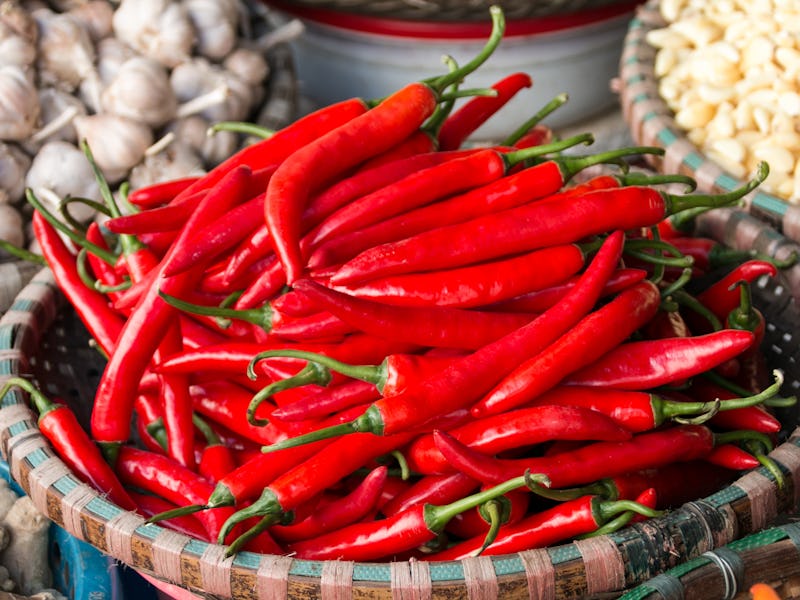Why does spicy food make you sweat? A neuroscientist breaks it down
The body isn’t in actual harm, but it responds as if it is.

One of Federica Genovese’s fondest memories of spicy food is how her grandmother would eat a plate of pasta: with a fork in one hand and a Calabrian chili in the other, she would alterate bites of pasta and chili. Genovese believes that as her grandma’s sense of smell and taste deteriorated with age, she actually became a more adventurous eater. Genovese’s mother, on the other hand, starts sweating the moment someone cuts into a pepper, no matter how far she is from the kitchen.
Most people lie somewhere in the middle. A neuroscientist and research associate at the Monell Chemical Senses Center in Philadelphia, Genovese knows all about how spicy food elicits various physiological reactions. Indeed, sweating bullets while eating well-seasoned hot pot is fairly common.
Genovese tells Inverse that when talking about smell and taste, one must account for another sense called chemesthesis, which she defines as a “chemical sense that perceives spiciness in general.” In other words, how sensitive a person is to various chemicals that are known to be spicy.
Why do I sweat when I eat spicy food?
The chemical responsible for that addictive fiery sensation in Buffalo wings is capsaicin, which naturally occurs in peppers. Capsaicin essentially tricks your brain into thinking you ate something both painful and hot.
How does it do this? When you eat something containing capsaicin, it binds to receptors on the tongue called TRPV1, which detect painful and hot things. The TRPV1 receptor then sends a signal to the brain saying that you’ve encountered something flaming and burning, even though you haven’t. Your body responds as if it has, though, by sweating — and also sneezing, coughing, and even crying, like when you cut onions. The strength of this reflex depends on the sensory input. Your body will respond more strongly to extreme spice than to a mild kick.
“Sweating is literally to wash out whatever got in contact with your mouth, your skin, and everything else,” Genovese says.
The body isn’t in actual harm, but it responds as if it is. That reaction is what can be harmful. While your nervous system is only trying to help you out, it overreacts. These reflexes lose precision because their purpose is to expel the threat as quickly as possible, which means opening up all possible escape routes. And, since the neurons perceive an increase in temperature, sweating is a great way to cool the body down.
As integral as these reactions may seem, researchers are still parsing the mechanisms behind reactions to temperature. In fact, the 2021 Nobel Prize in Physiology or Medicine was awarded to David Julius and Ardem Patapoutian for using capsaicin to discover TRPV1. They published their work in a groundbreaking 1997 paper, aiding in our understanding of touch and temperature sensations.
Is capsaicin toxic?
This chain reaction to capsaicin vilifies the molecule. The body is trying to expel something painful and hot, so maybe that means humans shouldn’t eat it in the first place.
“I will not define it as a toxin,” Genovese says. Just because the body detects something as a possible toxin doesn’t make it one. Genovese says what’s more interesting than human reactions to capsaicin is why plants evolved it in the first place.
She says it’s the perfect defense mechanism against predators. If you’ve ever bitten into a jalapeno seed, it’s not a fun time. This is part of the plant’s line of defense. “Capsaicin is released mostly from the seeds,” Genovese says. “You need to break the seed to release most of the capsaicin. If you eat and break the seed, then there are no seeds available anymore to create new plants.”
While capsaicin isn’t toxic to humans, sometimes it can trigger such a strong reaction that the body suffers harm, even to the point of a heart attack. Genovese says this dangerous reaction is more likely among people who compete in chili pepper-eating competitions, gulping Carolina reapers and ghost peppers.
How can I stop sweating when I eat spicy food?
The best option for the self-consciously sweaty who also love spicy food is to start pounding bottles of Cholula. This may seem counter-intuitive since capsaicin is the very thing that makes pit stains bloom and turns the forehead into a Slip N’ Slide, but building a tolerance to capsaicin is the best way to train the body to temper its reactions.
Slowly, your brain and body learn capsaicin is nothing to be scared of.
“Every time you eat spicy food, you survive,” Genovese says. “Your body figures out that’s not harmful somehow and doesn’t need the same amount of TRP receptor to detect this thing anymore.”
As your body becomes desensitized to capsaicin, it takes fewer and fewer TRPV1 receptors to sense the molecule. Since less of the receptor responds, it’s a much milder reaction. Genovese says this is why cultures with lots of spicy food have adults who can handle spice without breaking a sweat, and those from blander cultures might sneeze at the first hint of spice.
These days, Genovese herself has a “love and hate” relationship with spicy food. Thai curries are her favorites because the coconut milk base often tempers the ouch factor. She’s solidly between her spicy-sensitive mom and her chili-eating grandma.
CHECK, PLEASE is an Inverse series that uses biology, chemistry, and physics to debunk the biggest food myths and assumptions.
Now read this: What makes eggs organic? A USDA expert cracks open the complicated question